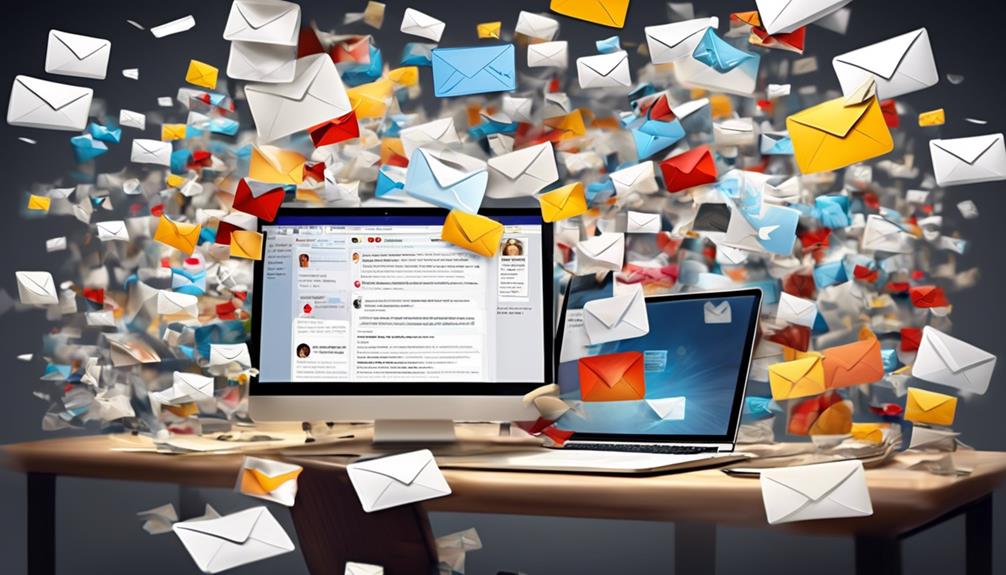When it comes to Correction Email Subject Lines, they serve as the key to fixing mistakes and maintaining customer trust. Getting them right is essential for success, but it can be difficult at times.
We’ve found that the approach to crafting these subject lines is more nuanced than one might think. Join us as we uncover the strategies and best practices that can make your correction email subject lines stand out and capture the attention of your recipients.
Key Takeaways
- Attention-grabbing subject lines are crucial for customer engagement and open rates in correction emails.
- Crafting effective subject lines involves clarity, honesty, and a customer-centered approach, while avoiding negative words and strong adjectives.
- The subject line should clearly communicate that the issue has been fixed and convey a clear message of customer satisfaction.
- Strategies for effective subject lines include addressing the error upfront, using positive language, and considering adding humor when appropriate.
Importance of Attention-Grabbing Subject Lines
Crafting attention-grabbing subject lines is crucial for ensuring customer engagement and open rates when sending correction emails. The subject line is the first impression a recipient has of the email and can significantly impact whether the email is opened or ignored. When it comes to correction emails, the importance of attention-grabbing subject lines becomes even more evident. A well-crafted subject line can help mitigate the negative impact of an error and maintain customer satisfaction.
In the case of a spelling mistake or error, a subject line that conveys sincerity, provides a solution, and reassures the recipient can be highly effective. Humor can also play a role in capturing the recipient’s attention, such as using ‘Oops!’ to acknowledge the mistake in a lighthearted manner. However, it’s essential to strike a balance and ensure that the subject line remains respectful and professional. Clarity and honesty are crucial, as the subject line should clearly communicate the error and its correction without being misleading.
Crafting attention-grabbing subject lines for correction emails is an art that, when mastered, can significantly improve open rates and customer engagement.
Crafting Effective Subject Lines

When addressing the importance of attention-grabbing subject lines in correction emails, it becomes essential to seamlessly transition to crafting effective subject lines that convey sincerity, provide a solution, and engage recipients from the moment they see the email.
Crafting an effective subject line for a correction email involves several key elements:
- Clarity, Honesty, and Customer-Centered Approach: The subject line should clearly communicate the purpose of the email correction, be honest about the mistake, and focus on how it benefits the recipient.
- Straightforwardness and Incorporating Humor: A clear and straightforward subject line can be complemented with humor, such as using ‘Oops!’ to acknowledge the mistake, creating a more engaging tone.
- Avoidance of Negative Words and Strong Adjectives: To maintain a positive tone, it’s important to avoid using negative words or strong adjectives in the subject line, which can deter recipients from opening the email.
- Opportunity for Brand Reputation Enhancement: Correction emails provide an opportunity to own up to mistakes, make amends, and enhance brand reputation with high open and engagement rates.
- Assessing the Severity of the Error: Before sending a correction email, it’s crucial to assess the severity of the error, as minor mistakes may not require a correction email to maintain customer satisfaction.
Best Practices for Subject Lines
We have found that incorporating attention-grabbing subject lines is crucial for effective correction emails. When sending a correction email, it’s essential to make sure the subject line clearly communicates that the issue has been fixed. Here are some best practices for crafting subject lines that will help ensure customer satisfaction and convey a clear and concise message:
| Common Mistakes | Subject Lines | Example Subject Line |
|---|---|---|
| Sending wrong info | “Correction: [Brief Description]” | “Correction: Updated Event Details” |
| Bad links | “Oops! We Fixed the Issue” | “Oops! We Fixed the Broken Link” |
| Non-functional pages | “Corrected Version: [Page/Link Title]” | “Corrected Version: Checkout Page” |
Tips for Noticing and Opening Emails

Upon receipt of an email, promptly review its contents to swiftly identify any potential errors or issues. Here are some tips for noticing and opening emails:
- Scan for Key Information: Quickly scan the email for important details such as the sender’s name, subject line, and any attachments.
- Check for Errors: Pay attention to any spelling or grammatical errors, as well as the overall coherence of the message.
- Assess Urgency: Determine the urgency of the email and prioritize accordingly, especially if it pertains to sending a correction email or addressing an issue in a particular program or service.
- Evaluate Subject Line: Assess whether the subject line effectively captures the essence of the email and entices the recipient to open it.
- Take Action: If the email requires a response or immediate action, consider the best course of action and respond accordingly.
Strategies for Effective Subject Lines
Crafting effective subject lines is essential for maximizing customer engagement and conveying the purpose of error correction emails with clarity and sincerity. When writing a correction email subject line, it’s crucial to address the error or mistake right from the start. Depending on the situation, using positive language instead of negative can help to soften the impact of the error and maintain a positive tone. Additionally, incorporating humor, when appropriate, can humanize the email and strengthen customer engagement. It’s important to remember that the subject line sets the tone for the entire email chain, so it should be the first thing to consider when strategizing for effective subject lines. Below is a table summarizing strategies for creating effective subject lines in correction email marketing.
| Strategies for Effective Subject Lines |
|---|
| Address the error upfront |
| Use positive language |
| Consider adding humor |
These strategies can help ensure that correction email subject lines are compelling, sincere, and effective in engaging customers.
Frequently Asked Questions
How Do You Say Correction in Email Subject?
We make corrections in email subjects by using attention-grabbing phrases like ‘Correction’ or ‘Oops’ to indicate the error. It’s important to promptly address the mistake and convey a positive sentiment to recipients.
What Do You Title an Email Correction?
We title an email correction with a clear and concise subject line that directly addresses the correction being made. This ensures that the recipient can easily identify and understand the purpose of the email.
How Do You Indicate a Correction in a Email?
We indicate a correction in an email by clearly stating the original error, providing the correct information, and offering an apology if necessary. This ensures transparency and helps to maintain trust and credibility.
How Do You Send a Professional Correction Email?
We send a professional correction email by acknowledging the mistake, providing the corrected information, and expressing regret for any inconvenience caused. We ensure clarity, brevity, and a respectful tone in our communication.
Conclusion
Well, we’ve certainly learned the importance of a good subject line, haven’t we? It’s amazing how a few words can make all the difference.
So, next time you’re sending out a correction email, remember to be clear, honest, and maybe even add a touch of humor. It’s all about grabbing attention and making things right.
Oops, did I just give away all our secrets?









